Abstract
The use of graphene nanoplatelets for several purposes such as barrier properties and structural health monitoring is widely studied in polymer-based coating technology. Nevertheless, their extremely good effect on wear resistance makes them particularly interesting for coating technology. The effect of graphene nanoplatelets addition on the wear behaviour of an epoxy resin was analysed. The effects of graphene nanoplatelets content (0–8 wt.%), morphology and functionalization in wear behaviour were analysed by evaluating the main wear parameters of the nanocomposites studied. The morphology of the wear surfaces was analysed by scanning electron microscopy (SEM) and 3D optical profilometry in order to evaluate the mechanism and severity of wear. The results showed that the wear behaviour of the epoxy resin improved considerably with the addition of graphene, especially for higher contents. Moreover, as the wear mechanism depends on the morphology of graphene nanoplatelets, it was concluded that the proper selection of graphene can be made depending on the chosen application.
1. Introduction
The wear resistance of polymers is a problem because their properties usually lead to severe and quick wear while in service. This fact has led to research regarding the possibility of improving this property by the addition of different discontinuous reinforcements such as short fibres and particles.
Two different approaches are usually explored to reach this objective. On one hand, the improvement of the mechanical properties may allow an enhancement of the wear resistance, reducing some of the non-adhesive mechanisms of wear. For example, the addition of short glass/carbon fibres was proved as a good alternative under certain wear conditions [1,2]. On the other hand, the use of particles that may act as solid lubricants may also be a good approach to improve the wear behaviour by creating films between the two counterparts during the test. For example, graphite can be used for this purpose [3,4].
The lubricating properties of graphite have been extensively studied and scientifically demonstrated [5,6,7]. The reason for this behaviour may be a structure of C-C covalent bond sheets, which are joined together by weak Van der Waals forces. Carbon nanotubes (CNTs) and graphene nanoplatelets (GNPs) are also constituted by one or more of these C-C sheets and should have a lubricating effect. For this reason, graphene may be an emerging solid lubricant that reduces friction between contact surfaces. Furthermore, the tribological behaviour of graphene is better than graphite due to the intercalation of water molecules between carbon sheets, which facilitates movement and reduces friction. Previous studies have shown that the deposition of a layer from a solution of ethanol with a small amount of graphene on a steel surface reduces both friction and wear in humid air and dry nitrogen [8,9].
The use of graphene and its derivatives as a reinforcement for polymer matrices has attracted a great interest because of their outstanding properties—not only mechanical but also electrical and thermal characteristics of the final nanocomposites—which have led to extensive research in electronic industry, protective coatings and electromechanical sensors, among others [10,11,12,13,14,15]. Taking the good results of graphite reinforcement as the basis [16], the addition of graphene should lead to an improvement of the wear properties at lower concentrations. As the number of particles per mass unit is higher due to the extremely low thickness of these nanoparticles, its addition could allow the creation of a lubricant film at the beginning of the material wear, thus reducing the following abrasion. This effect is extended to other graphene related nanoparticles, such as graphene oxide sheets, functionalized graphene sheets and so on. Although the presence of experimental studies based on epoxy/graphene are scarce, some studies have already demonstrated the potential use of this material family (polymer-/graphene-based nanoparticles). The addition of graphene nanoplatelets to polytetrafluoroethylene (PTFE), one of the most widely used solid lubricants, reduces the steady state wear rate four orders of magnitude [17]. The addition of graphene oxide nanosheets in a concentration of 0.1 wt.% to 3 wt.% results in a large decrease in the wear rate of ultra-high molecular weight polyethylene (UHMWPE), which is a material used for implants for the hip and knee [18,19].
Moreover, the addition of graphene to polymer matrices has an effect on two additional parameters commonly affecting the wear behaviour of polymers: Mechanical properties and temperature. The increase of the mechanical properties, mainly hardness and stiffness, due to the addition of graphene is not always achieved due to the formation of aggregates, weak interface interaction and poorer quality of the final material due to the increased difficulty of their processing conditions. Nevertheless, authors have reported increments in these properties when they totally or partially overcome these inconveniences [19,20,21,22,23]. Finally, the addition of graphene increases the thermal conductivity of the polymer matrix, improving heat dissipation during abrasion, which improves the wear behaviour observed and the glass transition temperature of the matrix, thus improving the thermal stability and retarding softening with temperature, which also depends on the interface and dispersion [24,25,26].
Other carbon-based nanoparticles have been studied for the wear behaviour improvement of polymer matrices. The use of multiwall carbon nanotubes (MWCNTs) allowed researchers to reduce the friction coefficient and wear rate with different results depending on the morphology (length), alignment and functionalization of the MWNCTs [27,28,29].
The addition of GNPs instead of single-layer graphene sheets allowed researchers to reduce the production costs of nanoparticles, thus reducing final material costs and allowing their use in most industries. The overall material cost can be increased by less than 0.01–0.05 €/g (depending on the content selected) while improving the wear and barrier properties, which would increase their service life, thus reducing maintenance and replacement costs, allowing an effective competitiveness with the current epoxy coatings used on metal and composite parts.
The present study demonstrates the efficacy of GNP as nanoreinforcements to decrease the wear of common engineering polymers such as epoxy resin. Moreover, it was demonstrated that higher contents allow achieving better wear results, which is very promising, as the use of graphene nanoplatelets instead of CNTs or individual graphene layers makes it possible to increase the content up to 8–10 wt.% with no severe manufacturing inconveniences, thus leading to nanocomposites with improved wear behaviour. Finally, the effect of functionalization was analysed for this type of nanoparticles, as the wear mechanism changed when amine functionalization was added to the graphene nanoparticle.
2. Experimental Procedure
2.1. Materials
Nanocomposites were based on a bicomponent epoxy resin (Araldite LY556 + Araldite XB3473, both from Huntsman, in mass ratio 100:23). As nanoreinforcements, two types of graphene nanoplatelets were used to study the influence of morphology and functionalization on wear properties. Nonfunctionalised GNPs (M25 from XGScience) had an average thickness and lateral size of 6–8 nm and 25 µm, respectively (Figure 1a,b). Amine-functionalised GNPs (f-GNPs), denominated Grade 4 by Cheaptubes, had an average lateral size of 5 μm and thickness below 4 nm (Figure 1c,d). The percentage of both types of graphene nanoplatelets was modified between 2 wt.% and 8 wt.%.
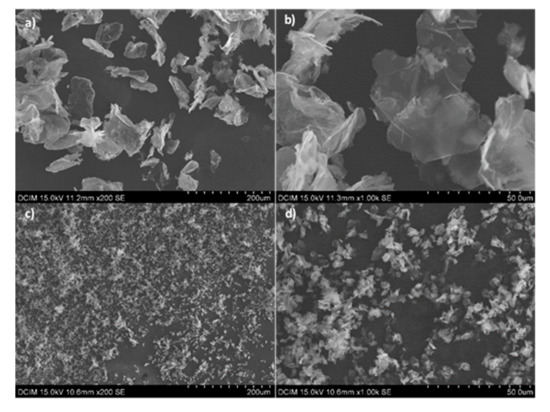
Figure 1.
Scanning electron microscopy (SEM) micrographs of two types of graphene nanoplatelets: nonfunctionalised (a,b) and functionalised (c,d).
2.2. Epoxy/GNPs Nanocomposites Preparation
Epoxy/GNPs nanocomposites with different types and contents of graphene nanoplatelets (GNPs) were prepared using a method that basically consisted of two steps: (1) A mechanical dispersion of graphene nanoparticles in the epoxy matrix, and (2) curing of the mixtures at 140 °C for 8 h. The dispersion of GNPs in the matrix was carried out using a three-roll-mill machine (mini-calendering) and applying the parameters optimized in previous research studies [30,31,32]. After this mechanical dispersion process, the mixture was maintained by stirring and was heated to a temperature of 80 °C to decrease its viscosity and enhance manufacturability. At this temperature, vacuum degassing was also done to avoid porosity in the material. Finally, the curing agent was added and mixed for 2 min to ensure homogeneity, and the mixture was poured into an open mould. The curing cycle was performed inside an oven for 8 h at 140 °C. This procedure was performed both to manufacture the neat epoxy resin (without GNPs) and the epoxy resins with GNPs percentages of 2 wt.%, 3 wt.%, 5 wt.% and 8 wt.%.
2.3. Characterization and Wear Tests
Microstructural characterization of epoxy/GNPs nanocomposites was done by scanning electron microscopy (SEM) using a Hitachi S-3400N to evaluate the dispersion of GNPs in the epoxy matrix.
A Mettler Toledo balance (±0.001 mg) equipped with a density determination kit by means of the buoyancy technique (Archimedes method) was used to evaluate the change of density in the epoxy resin by the addition of different GNPs contents. Five measurements were made for each material, and the average value and standard deviation were determined.
Vickers microhardness measurements were carried out using a microhardness indenter (Micro Hardness Tester Shimadzu) by applying a load of 300 mN (HV0.3) for 15 s. The results of this test are the average of at least 10 indentations.
The samples surface preparation was performed prior to the wear tests. They were ground with different emery papers to obtain a similar surface roughness that would not influence the wear properties. The average roughness of the samples, determined by a profilometer Mitutoyo SJ-301 Surftest, was 0.37 ± 0.05 μm.
Wear tests were carried out on a pin-on-disc tribometer in dry conditions and with the same environmental conditions. The main wear parameters affecting the test were optimized in previous research [18]: A 6 mm diameter alumina ball, 10 N load, 0.09 m/s speed and test distance of 1000 m. Five wear tests were made for each material, and the average value and standard deviation were determined. The tribological behaviour was evaluated by measuring the mass loss, friction coefficient (μ) and wear rate (Q) of the epoxy/GNP nanocomposites. The wear testing machine continuously recorded the friction coefficient. Mass loss was determined by weighing the samples before and after the wear test and volume lost was calculated from the same value using density properties previously determined. Moreover, Archard’s law was applied to determine the wear rate, as it was linear with the sliding distance [33].
Finally, worn surfaces were analysed by SEM and 3D optical profilometer to define the main wear mechanisms. The width of the wear track was measured by optical microscopy using digital image analysis software included in the profilometer. These measurements allowed us to assess the severity of the wear.
3. Results and Discussion
3.1. Characterization of Nanocomposites
Figure 2 shows the microstructure of epoxy/GNPs nanocomposites. It can be observed that the achieved nanoreinforcement distribution was quite homogeneous. The disaggregation of the agglomerates and good dispersion of the two types of graphene nanoplatelets in the resin were reached using the calendering process. This homogeneous dispersion was achieved even for the higher percentages of 8 wt.% (Figure 2b). The graphene was homogeneously distributed throughout all the resin, and no areas free of nanorefoircement or porosity were observed.
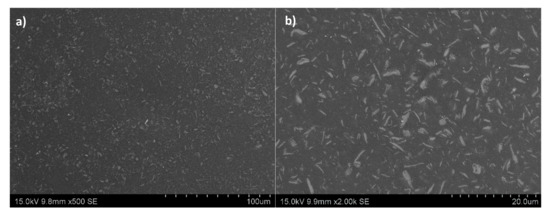
Figure 2.
SEM images of the dispersion achieved in the epoxy/graphene nanoplatelets (GNPs) nanocomposites: (a) With 5 wt.% of nonfunctionalised GNPs and (b) 8 wt.% of functionalised GNPs.
The density values and Vickers microhardness of epoxy/GNPs nanocomposites as a function of GNP content are shown in Figure 3. The density values (blue circles in Figure 3) increased slightly as the content of GNPs in the epoxy resins increased. However, it can be considered that density remained roughly constant. For the material with 8 wt.% of GNPs, the density only increased from 1.17 g/cm3 to 1.19 g/cm3. For the potential applications of these materials, density values are important.
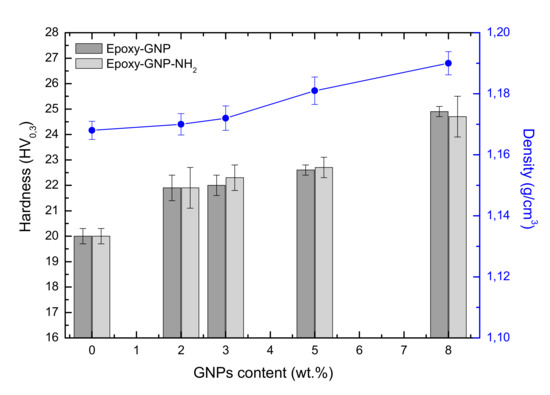
Figure 3.
Variation of microhardness (columns) and density (blue circles) of epoxy/GNPs nanocomposites as a function of GNPs content.
Microhardness was evaluated to study its possible effect on the wear behaviour of materials. When the content of the two types of GNPs increased (columns in Figure 3), the microhardness values enhanced slightly. However, these differences were very small. This increase was only greater (around 25%) for percentages of 8 wt.% of GNPs. Comparing the influence of the type of GNPs, it can be observed that the microhardness values were similar for the same content of graphene nanoplatelets. In summary, as the microhardness values obtained were similar for all epoxy/GNP nanocomposites studied, we can conclude that this variable had no influence on wear properties, at least for contents lower than 8 wt.%.
3.2. Tribological Properties
Figure 4 presents mass loss (Figure 4a) and wear rate (Figure 4b) for the epoxy/GNPs nanocomposites studied. Both wear parameters decreased when GNPs were added to the epoxy resin, regardless of the type. This decrease was more pronounced for materials with 5 wt.% and 8 wt.% of GNPs. When analysing the nanocomposites with 8 wt.% of the two types of GNPs, the mass loss and the wear rate were in values of 0.2 mg and 0.1·10−3 mm3/m, respectively. Also, Figure 4 shows the differences between the two types of GNPs. It can be observed that the analysed values were slightly lower when f-GNPs were used. However, considering the error of measurements, these differences were insignificant. In view of these results, it can be concluded that the increase of GNPs content in the epoxy resin, regardless of the type of GNPs, significantly reduced its mass loss and wear.
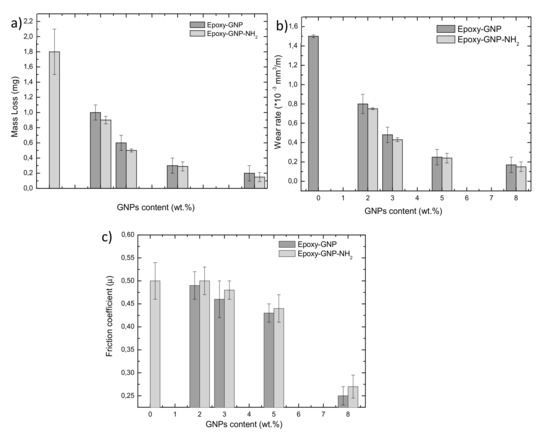
Figure 4.
Mass loss (a), wear rate (b) and friction coefficient (c) of epoxy/GNPs nanocomposites with different contents and types of GNPs.
The effect of graphene nanoplatelets content on the friction coefficient is presented in Figure 4c. It can be observed that at a low GNP percentage, the friction coefficient was similar to the neat epoxy resin with values near 0.5. However, when the percentages were higher (8 wt.%), a sharp drop in the friction coefficient occurred, reaching values near 0.25 for the two types of GNPs. This low friction coefficient observed in the materials containing 8 wt.% of GNPs can be related to the lubricating effect of the GNPs. They facilitated a relative movement between surfaces, i.e., they reduced the friction force needed to overcome the friction generated between the pin and the material with respect to the unlubricated surfaces. Other authors have already confirmed this effect of graphene on the friction coefficient decrease. Saurin et al. [34] showed that the addition of 0.1 wt.% of graphene particles to epoxy resin reduced the friction coefficient by 70.26%, and Berman et al. [7] demonstrated that the lubrication of a steel surface with a layer of liquid ethanol with graphene also reduced the friction coefficient by four orders of magnitude.
Regarding the influence of the type of GNPs, it can be observed that the friction coefficient of the materials containing f-GNPs was slightly higher than that of the materials with GNPs. As discussed in the analysis of the worn surfaces, a tribological layer (debris) was formed on these materials. The epoxy resin detached with graphene nanoplatelets torn during the test due to the higher interface resistance created between amino functionalised GNPs and the matrix. The epoxy resin constituted this debris. The debris can act as a third body in the wear mechanism, thus increasing the real contact surface and producing this slight increase in friction coefficient [35,36].
3.3. Characterization of the Wear Surfaces
The wear mechanisms were studied by analysing the wear track surfaces using SEM and 3D optical profilometry. Although the type of GNP did not seem to have a great influence on the wear behaviour (mass loss, wear rate and friction coefficient), the analysis of the worn surfaces indicates that the wear mechanism was very different.
Figure 5 shows the track width value and profilometer images of the wear track for different nanocomposites. As depth values of wear tracks were very low, the discussion was based on track wideness. For both types of graphene, at higher GNPs contents (5 wt.% and 8 wt.%), width and roughness of the wear surfaces decrease considerably compared to epoxy resin (Figure 5b). In the case of materials with 8 wt.% of graphene, the wear track width was reduced by approximately reduced with respect to that of the neat resin (from 1194 μm to 520–540 μm). In the case of materials containing 8 wt.% f-GNPs, despite the 1000 m track made by the alumina pin on material, the wear track generated on the filled resin was very small in terms of depth. In fact, the track depth could not be evaluated, as it was in the same range as the part surface roughness, whereas for neat resin, the track depth was in the range 75–100 µm. The material with 8 wt.% GNP behaved as if the pin slid on the material (Figure 5e).
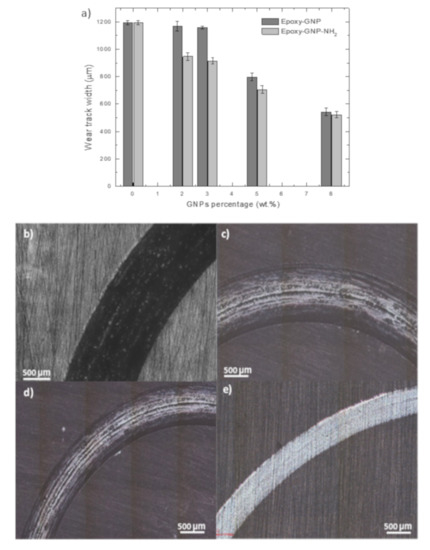
Figure 5.
Wear track width (a) and 2D Profilometer images of wear track of neat epoxy (b), and epoxy with 3 wt.% non-functionalised GNPs (c), 3 wt.% amino-functionalised GNPs (d) and 8 wt.% amino-functionalised GNPs (e).
However, for low percentages of graphene (2 wt.% and 3 wt.%), the value of wear track width of materials with non-functionalised GNPs was similar to neat resin and remained almost constant. On the other hand, it can be observed that the wear track width was lower than the reference one, even at low contents when f-GNPs were used (Figure 5d). According to this result, the damage or wear made by the pin on the surface was less for graphene functionalised with the amino group. This effect has been observed in previous studies that were carried out on nanocomposites with carbon nanotubes (MWCNTs). In this study, for nanocomposites with nonfunctionalised MWCNTs, the wear track width was not strongly affected by the increase of MWCNT content. However, for nanocomposite with amine functionalised MWCNTs, the track width decreased considerably, even at the lowest percentages (2 wt.%) [18]. This improvement of the interface, which leads to a strongly attached resin layer covering the GNPs when they are amine-functionalised, has been already reported for the same epoxy/GNP system used for the current research. Thus, it is the effect found in the debris generated when amine-functionalised GNPs were used [37]. Moreover, the lower thickness and lateral size could better enhance this interface between the resin and the f-GNPs.
Wear surfaces have been also analysed by scanning electron microscopy to evaluate the wear mechanisms (Figure 6 and Figure 7). In general, the wear damage decreased when GNPs were added to the epoxy resin for both types of GNPs. However, the morphology of the wear surfaces depended on the percentage of graphene. For low contents, they were similar for the two types of graphene, but at higher percentages, they were very different. In the case of the epoxy resin (Figure 6a,c) and the nanocomposite with 2 wt.% of graphene (Figure 6b,c), the observed wear track had higher width and roughness, indicating mainly abrasive and adhesive wear mechanisms. In these materials, two different wear zones could be distinguished. In the first wear zone, the material was torn out during the test (abrasive wear mechanism), and in the other wear zone, the removed material from the track (debris) was crushed during ball movement (adhesive wear mechanism). This adhesive wear caused by the crushing of the removed material was more evident at the edges of the wear track where the material crushed had accumulated due to cyclic alumina ball movement in the wear test. This wear mechanism is the same as that observed in epoxy/MWCNT nanocomposites [18].
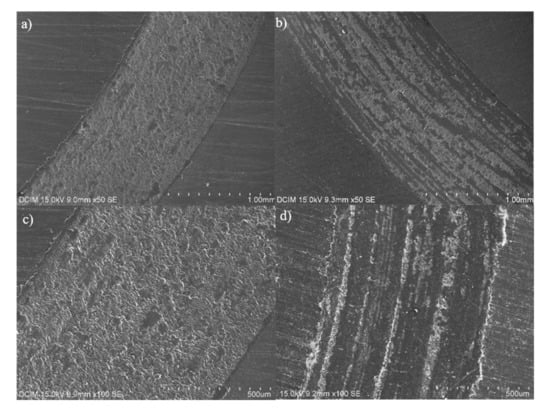
Figure 6.
SEM images of worn surfaces of neat epoxy (a,c) and 2 wt.% of non-functionalised GNPs (b) and 2 wt.% amino functionalised GNPs (d) nanocomposites.
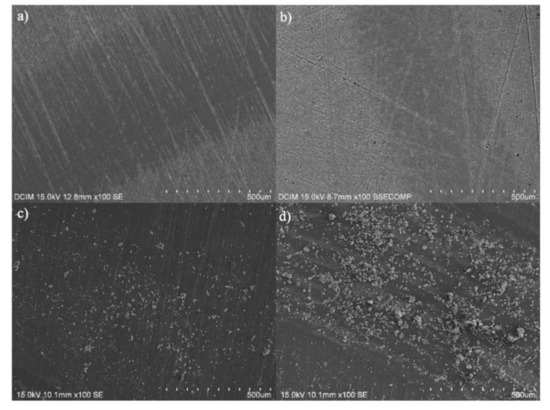
Figure 7.
SEM images of worn surfaces of nanocomposites with 5 wt.% (a) and 8 wt.% (b) of non-functionalised GNPs and 5 wt.% (c) and 8 wt.% (d) of amino-functionalised GNPs.
However, at higher percentages of GNPs (5 wt.% and 8 wt.%), wear surfaces were different depending on the type of graphene, indicating that the wear mechanism was different (Figure 7). For the nanocomposites with non-functionalised graphene, an increment of GNP content up to 5 wt.% and 8 wt.% resulted in a wear track that was almost imperceptible (Figure 7a,b). For these materials, the wear track had no roughness, almost no tearing of material took place during test, and even the initial surface preparation of the sample was distinguished. This observation confirms that, in the case of the epoxy resin filled with 5–8 wt.% of non-functionalised GNPs, the graphene acts as a lubricant inside of the epoxy resin. The lubricating effect of the graphene inside the resin favoured the pin sliding and, consequently, almost no wear track was observed and no debris detached during the test.
In the case of nanocomposites with amino-functionalised GNPs, the surface was less smooth and debris were deposited (Figure 7c,d), while these debris were not observed in samples containing non-functionalised GNPs. In nanocomposites with amino-functionalised GNPs, a film was formed between the pin and surface, which acted as a lubricant. Other studies on the mechanism by which graphene acts as a lubricant and reduces friction between surfaces have shown that it was associated with the formation of a graphene uniform layer within the area of track wear [10].
This difference in the wear mechanism, according to the type of graphene, was mainly observed at higher magnification (Figure 8). For low percentages of GNPs, material with non-functionalised GNPs had a rough surface, indicating an abrasive wear similar to that of the epoxy resin (Figure 8a). On the other hand, for amino-functionalised graphene, it was observed that for the same percentage, the surface was smoother and there was less abrasive wear. Although the percentage of graphene was also low, debris particles (GNPs + epoxy) detached and adhered to the surface, acting as a third body, which was the lubricant (Figure 8b).
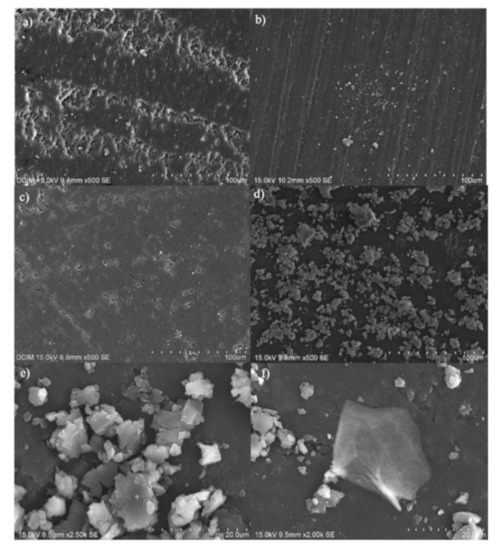
Figure 8.
SEM images of worn surfaces of nanocomposites with 3 wt.% and 8 wt.% of non-functionalised GNPs (a,c) and amino-functionalised GNPs (b,d), respectively. SEM images of the debris particles detached during test (e,f).
At higher percentages (8 wt.%), the difference in wear mechanism was even greater. The material surface of non-functionalised graphene was practically smooth, that is, there was almost no wear track and no material was detached on the surface (Figure 8c). However, in the wear surface of the nanocomposite with amino-functionalised GNPs, material detached during the test, which acted as a lubricating layer (Figure 8d). The debris deposited on the surface are shown in Figure 8e,f. It can be observed the debris was a mixture of epoxy resin and graphene because the bonding of this functionalised graphene with the resin was higher, thus they detached together. This stronger interface between f-GNP and the epoxy resin resulted in the presence of nanocomposite-based debris instead of single GNPs. As explained when discussing the friction rate, the lower size of the f-GNPs when compared to non-functionalised ones and/or the chemical interaction between amine groups and epoxy monomer resulted in stronger interfaces that promoted the detachment of resin and f-GNPs together.
4. Conclusions
The addition of graphene nanoplatelets up to contents of 8 wt.% almost did not modify the density and hardness of the epoxy resin. Therefore, the improvements in the wear behaviour of the epoxy/GNP nanocomposites observed were not due to hardness increase by the addition of GNPs.
The wear behaviour of the epoxy resin improved with the addition of two types of graphene nanoplatelets tested. The mass loss, wear rate and friction coefficient decreased with the increasing graphene contents. This effect was more marked for nanocomposites with 5 wt.% and 8 wt.% of GNPs.
The incorporation of high percentages of the two types of graphene nanoplatelets provoked a decrease in the width and depth of wear track surfaces. Nevertheless, the wear mechanism depended on the GNP type.
When using non-functionalised GNPs, the improvement in the wear behaviour was due to the fact that graphene acted as a lubricant from inside the epoxy resin. This effect was observed mainly at higher percentages of graphene, since at low contents, the behaviour was similar to that observed in the neat epoxy resin. Almost no wear was observed in resin reinforced with 8 wt.% of non-functionalised GNPs, in which the wear track was smooth, justifying the lubricant effect.
However, in the materials reinforced with f-GNPs, the improvement in the wear behaviour was due to its detachment from the material and subsequent adherence to the surface acting afterward as a lubricating layer. The smaller size and/or functionalization promoted the detachment of epoxy and f-GNPs together.
The main conclusion is that the addition of 5–8 wt.% of the two types of graphene nanoplatelets to the epoxy resin improved its tribological properties due to the lubricant effect of graphene that decreased friction with ceramic alumina bearings.
Author Contributions
M.C. prepared the research methodology as well as the results analysis and preparation of the initial version of the manuscript. A.J.-S. contributed to the experimental manufacturing and testing, preparation of the final version and revisions of the manuscript and funding acquisition. A.U. contributed to funding acquisition. All authors have read and agreed to the published version of the manuscript.
Funding
This research was funded by Young Researchers R&D Project (Ref. M2183, SMART-MULTICOAT) financed by Universidad Rey Juan Carlos and Comunidad de Madrid; Ministerio de Economía y Competitividad (project MAT2016-78825-C2-1-R) and Comunidad de Madrid (ADITIMAT-CM S2018/NMT-4411).
Conflicts of Interest
The authors declare no conflict of interest.
References
- Friedrich, K.; Zhang, Z.; Schlarb, A.K. Effects of various fillers on the sliding wear of polymer composites. Compos. Sci. Technol. 2005, 65, 2329–2343. [Google Scholar] [CrossRef]
- Voss, H.; Friedrich, K. On the wear behavior of short-fibre-reinforced peek composites. Wear 1987, 116, 1–18. [Google Scholar] [CrossRef]
- Pan, G.; Guo, Q.; Ding, J.; Zhang, W.; Wang, X. Tribological behaviors of graphite/epoxy two-phase composite coatings. Tribol. Int. 2010, 43, 1318–1325. [Google Scholar] [CrossRef]
- Katiyar, J.K.; Sinha, S.K.; Kumar, A. Friction and wear durability study of epoxy-based polymer (SU-8) composite coatings with talc and graphite as fillers. Wear 2016, 362–363, 199–208. [Google Scholar] [CrossRef]
- Buckley, D.H.; Brainar, W. A Friction and wear of metals in contact with pyrolytic graphite. Carbon 1975, 13, 501–508. [Google Scholar] [CrossRef]
- Ruan, J.A.; Bhushan, B. Frictional behavior of highly oriented pyrolytic graphite. Appl. Phys. 1994, 76, 8117–8120. [Google Scholar] [CrossRef]
- Berman, D.; Erdemir, A.; Sumant, A.V. Few layer graphene to reduce wear and friction on sliding steel surfaces. Carbon 2013, 54, 454–459. [Google Scholar] [CrossRef]
- Berman, D.; Erdemir, A.; Sumant, A.V. Reduced wear and friction enabled by graphene layers on sliding steel surfaces in dry nitrogen. Carbon 2013, 59, 167–175. [Google Scholar] [CrossRef]
- Lin, J.; Wang, L.; Chen, G. Modification of graphene platelets and their tribological properties as lubricant additive. Tribol. Lett. 2011, 41, 209–215. [Google Scholar] [CrossRef]
- Prolongo, S.G.; Moriche, R.; Jiménez-Suárez, A.; Sánchez, M.; Ureña, A. Advantages and disadvantages of the addition of graphene nanoplatelets to epoxy resins. Eur. Polym. J. 2014, 61, 206–214. [Google Scholar] [CrossRef]
- Atif, R.; Shyha, I.; Inam, F. Mechanical, thermal, and electrical properties of graphene-epoxy nanocomposites—A review. Polym. Basel 2016, 8, 281. [Google Scholar] [CrossRef] [PubMed]
- Wang, Y.; Yu, J.; Dai, W.; Song, Y.; Wang, D.; Zeng, L.; Jiang, N. Enhanced thermal and electrical properties of epoxy composites reinforced with graphene nanoplatelets. Polym. Compos. 2015, 36, 556–565. [Google Scholar] [CrossRef]
- Chiacchiarelli, L.M.; Rallini, M.; Monti, M.; Puglia, D.; Kenny, J.M.; Torre, L. The role of irreversible and reversible phenomena in the piezoresistive behavior of graphene epoxy nanocomposites applied to structural health monitoring. Compos. Sci. Technol. 2013, 80, 73–79. [Google Scholar] [CrossRef]
- Kugler, S.; Kowalczyk, K.; Spychaj, T. Influence of synthetic and bio-based amine curing agents on properties of solventless epoxy varnishes and coatings with carbon nanofillers. Prog. Org. Coat. 2017, 109, 83–91. [Google Scholar] [CrossRef]
- Krishnamoorthy, K.; Jeyasubramanian, K.; Premanathan, M.; Subbiah, G.; Shin, H.S.; Kim, S.J. Graphene oxide nanopaint. Carbon 2014, 72, 328–337. [Google Scholar] [CrossRef]
- Zhang, Z.; Breidt, C.; Chang, L.; Haupert, F.; Friedrich, K. Enhancement of the war resistance of epoxy: Short carbon fibre, graphite, PTFE and nano-TiO2. Compos. Part A Appl. Sci. 2004, 35, 1385–1392. [Google Scholar] [CrossRef]
- Sanes, J.; Carrion-Vilches, F.J.; Bermudez, M.D. New epoxy-ionic liquid dispersions. Room temperature ionic liquid as lubricant of epoxy resin-stainless steel contacts. e-Polymers 2007, 5, 1–12. [Google Scholar] [CrossRef]
- Campo, M.; Jiménez-Suárez, A.; Ureña, A. Effect of type, percentage and dispersion method of multi-walled carbon nanotubes on tribological properties of epoxy composites. Wear 2015, 324–325, 100–108. [Google Scholar] [CrossRef]
- Wan, Y.-J.; Tang, L.-C.; Yan, D.; Zhao, L.; Li, Y.-B.; Wu, L.-B.; Jiang, J.-X.; Lai, G.-Q. Improved dispersion and interface in the graphene/epoxy composites via a facile surfactant-assisted process. Compos. Sci. Technol. 2013, 82, 60–68. [Google Scholar] [CrossRef]
- Tang, L.-C.; Wan, Y.-J.; Yan, D.; Pei, Y.-B.; Zhao, L.; Li, Y.-B.; Wu, L.-B.; Jiang, J.-X.; Lai, G.-Q. The effect of graphene dispersion on the mechanical properties of graphene/epoxy composites. Carbon 2013, 60, 16–27. [Google Scholar] [CrossRef]
- Shokrieh, M.M.; Hosseinkhani, M.R.; Naimi-Jamal, M.R.; Tourani, H. Nanoindentation and nanoscratch investigations on graphene-based nanocomposites. Polym Test. 2013, 32, 45–51. [Google Scholar] [CrossRef]
- Martín-Gallego, M.; Verdejo, R.; López-Manchado, M.A.; Sangermano, M. Epoxy-graphene UV-cured nanocomposites. Polymer 2011, 52, 4664–4669. [Google Scholar] [CrossRef]
- Prolongo, S.G.; Jiménez-Suárez, A.; Moriche, R.; Ureña, A. Advantages and disadvantages of the addition of graphene nanoplatelets to epoxy resins. Eur. Polym. J. 2014, 53, 292–301. [Google Scholar] [CrossRef]
- Teng, C.-C.; Ma, C.-C.M.; Lu, C.-H.; Yang, S.-Y.; Lee, S.-H.; Hsiao, M.-C.; Yen, M.-Y.; Chiou, K.-C.; Lee, T.-M. Thermal conductivity and structure of non-covalent functionalized graphene/epoxy composites. Carbon 2011, 49, 5107–5116. [Google Scholar] [CrossRef]
- Yu, A.; Ramesh, P.; Itkis, M.E.; Bekyarova, E.; Haddon, R.C. Graphite nanoplatelet-epoxy composite thermal interface materials. J. Phys. Chem. C 2007, 111, 7565–7569. [Google Scholar] [CrossRef]
- Prolongo, S.G.; Moriche, R.; Jiménez-Suárez, A.; Sánchez, M.; Ureña, A. Epoxy adhesives modified with graphene for thermal interface materials. Int. J. Adhes. Adhes. 2014, 90, 835–847. [Google Scholar] [CrossRef]
- Wang, H.; Chang, L.; Yang, X.; Yuan, L.; Ye, L.; Zhu, Y.; Harris, A.T.; Minett, A.I.; Trimby, P.; Friedrich, K. Anisotropy in tribological performances of long aligned carbon nanotubes/polymer composites. Carbon 2014, 67, 38–47. [Google Scholar] [CrossRef]
- Sakka, M.M.; Antar, Z.; Elleuch, K.; Feller, J.F. Tribological response of an epoxy matrix filled with graphite and/or carbon nanotubes. Friction 2017, 5, 171–182. [Google Scholar] [CrossRef]
- Cui, L.-J.; Geng, H.-Z.; Wang, W.-Y.; Chen, L.-T.; Gao, J. Functionalization of multi-wall carbon nanotubes to reduce the coefficient of the friction and improve the wear resistance of multi-wall carbon nanotube/epoxy composites. Carbon 2013, 54, 277–282. [Google Scholar] [CrossRef]
- Moriche, R.; Prolongo, S.G.; Sánchez, M.; Jiménez-Suárez, A.; Sayagués, M.J.; Ureña, A. Morphological changes on graphene nanoplatelets induced during dispersion into an epoxy resin by different methods. Compos. Part B Eng. 2015, 72, 199–205. [Google Scholar] [CrossRef]
- Jiménez-Suárez, A.; Campo, M.; Sánchez, M.; Romón, C.; Ureña, A. Influence of the functionalization of carbon nanotubes on calendering dispersion effectiveness in a low viscosity resin for VARIM processes. Compos. Part B Eng. 2012, 43, 3442–3490. [Google Scholar]
- Jiménez-Suárez, A.; Campo, M.; Gaztelumendi, I.; Markaide, N.; Sánchez, M.; Ureña, A. The influence of mechanical dispersion of MWCNT in epoxy matrix by calendering method: Batch method versus time controlled. Compos. Part B Eng. 2013, 48, 88–94. [Google Scholar] [CrossRef]
- Archard, J.F. Wear Control: Handbook; American Society of Mechanical Enginers: New York, NY, USA, 1980. [Google Scholar]
- Serrano, N.S.; Molina, J.S.; Bermúdez Olivares, M.D. Nuevos nanocomposites grafeno/líquido iónico en matriz epoxi. Anu. Jóvenes Investig. 2014, 7, 25–26. [Google Scholar]
- Dasari, A.; Yu, Z.Z.; Mai, Y.W. Fundamental aspects and recent progress on wear/scratch damage in polymer nanocomposites. Mater. Sci. Eng. R. 2009, 63, 31–80. [Google Scholar] [CrossRef]
- Burris, D.L.; Boesl, B.; Bourne, G.R.; Sawyer, W.G. Polymeric nanocomposites for tribological applications. Macromol. Mater. Eng. 2007, 292, 387–400. [Google Scholar] [CrossRef]
- Moriche, R.; Sanchez, M.; Jimenez-Suarez, A.; Prolongo, S.G.; Ureña, A. Electrically conductive functionalized-GNP/epoxy based composites: From nanocomposite to multiscale glass fibre composite material. Compos. Part B Eng. 2016, 98, 49–55. [Google Scholar] [CrossRef]
© 2020 by the authors. Licensee MDPI, Basel, Switzerland. This article is an open access article distributed under the terms and conditions of the Creative Commons Attribution (CC BY) license (http://creativecommons.org/licenses/by/4.0/).